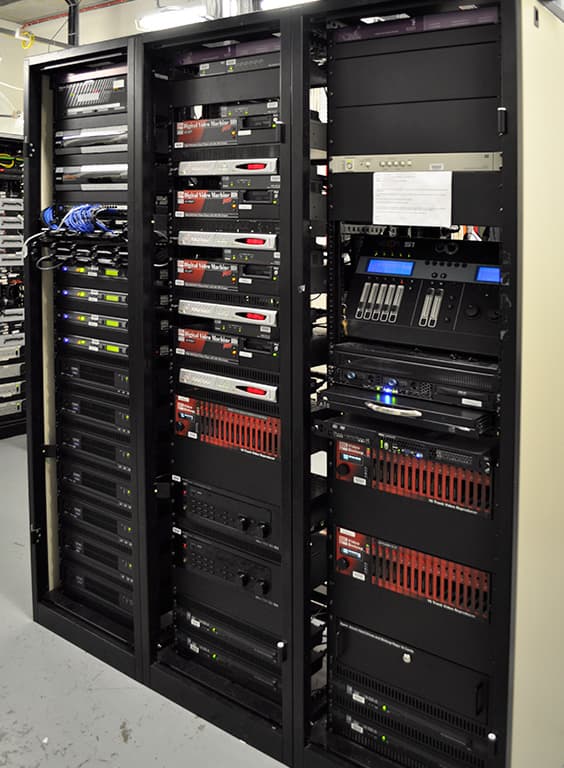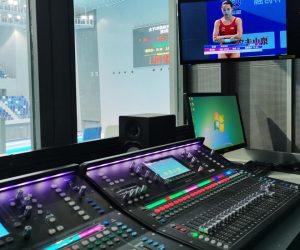
National Museum Comes Round
Tired old museum exhibits? They're history.
Text:/ Tim Stackpool
Images:/ Andrew Leiper
Gone are the days when museums were filled with ancient artifacts, preserved insects under glass with nutty curators holding casual banter with petrified mummies. The vision for the National Museum of Australia, for example, is for it to remain a world class repository of history and culture “illuminating the present and imagining the future”, while providing visitors with something new every time they visit. To this end, local AV systems engineers Wizard Projects were engaged to join the team, refurbishing the display and design of the Museum’s ‘Circa’ gallery. The gallery, so named for its circular-like visitor experience, is a revolving theatre that introduces the guests to objects they can expect to encounter during their visit. Working with Steven Fox, former Manager of Redevelopment, and local designers Bearcage, the completed project had to adhere to the main premise of being a visual journey, travelling from the Dreamtime to contemporary Australia.
Systems engineer and programmer Adam Breau with Wizard Projects recognised from the onset that, like most significant AV installations, the nature of the venue presents the first of many unique challenges. “Working in a museum environment increases the level of detail that is required when it comes to the installation and maintenance of all equipment installed,” he said. “Time-lines and installation schedules have to take into account the installation of museum objects and artifacts. The installation process is complex, with requirements such as dust extraction on drilling equipment a must, and major works needing to be done offsite to ensure that there is no possibility of damage to these irreplaceable objects.”
HISTORY IN FOUR PARTS
The systems integrators also discovered that working with many different contractors within the gallery space also provided challenges as the installation area did not allow for multiple tradespeople to work in the same area due to the space restrictions. Project management of the installation process, while providing the museum with an excellent result, proved to be a complex task. “The specification of very large non-standard aspect ratio projection screens for example, coupled with extremely short-throw projection required an extremely innovative solution,” Breau said.
Wizard utilised products from within the AV and electronic controls industries. These products, integrated with control hardware from AMX, brought all the elements together to provide the show. Wizard conceded that the acquisition of the hardware was not challenging in itself, but combining all the technologies into one integrated presentation took some creative thinking.
It’s important to note that the brief described Circa as a ‘transition zone’ between the world outside the Museum and the permanent exhibitions. Specifically, “its role is to conceptually orient diverse audiences to the Museum’s thematic interests in Australian history and its object-centred approach to representing Australian experiences”. [No mention of massacring the English language then? – Ed.] Wordy, yes, but the practical aspect is a little more straightforward. Circa is separated into four quadrants (or stages) providing the visitor with a chronological sweep of Australian history. Being virtually 100% multimedia-based, an AMX NetLinx system was deployed to control all facets of the rotating theatre. Some 26 NXC-COM2 and two NXC-I/O 10 were installed to expand the AMX NI-4100 to a level that allowed every device to be monitored and controlled, providing the maintenance and operations staff with feedback, both on the MVP-8400i control surface and on the museum’s new Resource Management Suite (RMS).
ROUND WE GO
Here’s how the visitor experience unfolds: When first approaching Circa, the museum guests are greeted by a Visitor Service operator who welcomes guests and doubles as the ‘exhibit operator’. This person oversees the presentation and ensures the show continues to operate. Primarily they also undertake an OH&S function, as visitors are required to exit their particular quadrant before a ‘clear to rotate function’ is engaged and the turntable rotates for the next session and next group of visitors to enter. Once the turntable is engaged, control is handed over to the AMX system, which then opens the load door to allow the next group of visitors to proceed onto the turntable.
Upon entering Circa, the show is quiet with a light background score that slowly builds to an announcement about visitor safety and the closing of the entry doors. Once closed, this triggers the AMX to bring the theatre to life with a presentation spread across a 6m-wide x 1.5m-high curved screen. While not a conventional format screen, two Silicon Optix Image Anyplace units are utilised to provide the edge blend and warping duties required between the four Projectiondesign F30 SX+ projectors. While the viewer is experiencing a display of imagery of Australia and its landscape, there are also nine Planar Clarity Bobcats on the roof providing similar imagery. These in conjunction with programmed lighting prepare the audience for the rest of their visit to the museum. The turntable then rotates and the audience is transported to the next quadrant.
Quadrant 2 starts with the eight screens slowly filling with images of various objects accompanied by audio snippets from multiple locations throughout the quadrant. The EAW JFX88 speakers are powered by two QSC CX404 amplifiers backed up by QSC Basis 922uz for processing. This is controlled by the AMX system and is continually monitored to ensure that it’s online and operating. From the MVP 8400i, the operators can un-mute a microphone at the operator console and talk at any time to all or individual quadrants within Circa.
Once again at the completion of the ‘clear to rotate’, the AMX system sets-up and prepares the equipment for the entry to the next loop. When started, the visitors are rotated into Quadrant 3, where they are confronted by another 6m-wide screen. Again, the edge blending is undertaken by the Silicon Optix Image Anyplace.
Turning into Quadrant 4 the visitors are greeted by Bruce Gyngell uttering the now famous words “Good evening and welcome to television”. Seconds after he finishes, 21 NEC plasma screens come to life with imagery and objects, all perfectly in sync. This is achieved using the Alcorn McBride Binloop. The playback system for Circa consists of three Binloop card frames and four HD DVM Pros.
Upon the timely exit of patrons from Quadrant 4 and the successful operation of the ‘clear to rotate’ command, the show seamlessly moves into a loop and starts the turntable again, moving the next batch of visitors into the the next quadrant, and so on.

CONTROL
While all AV elements of the show are controlled by the AMX system, mechanically the turntable is controlled by a Programmable Logic Controller (PLC). The Visitor Service operator maintains control of the show via the PLC panel, with the PLC instigating all the turntable rotations and safety features. The PLC was retained from the previous incarnation of Circa, and presented some integration challenges due to the differences between Circa version 1 and version 2. As the PLC’s previous programming was retained, it only allowed for minimal communication between the PLC and AMX systems. “It was like having to choreograph a dance piece where there is very little communication between two dancers, and the time to turn is flexible and not set to a particular point in the music, it just happens when it happens and you’d better be ready for it,” Adam Breau said.
Given the amount of public immersion in the display, liability as well as occupational health and safety issues needed to be addressed. The safety features within the theatre are incorporated into the PLC system. Wizard Projects also installed secondary devices to provide further detailed information to the operators, allowing them to make a more informed decision as to whether to stop the show or continue its operation, depending on unforeseen circumstances. The installation of such sensors and cameras within a revolving theatre proved difficult, as cabling obviously cannot revolve with the turntable. Instead, Wizard Projects utilised wireless systems to provide communications with some devices within the system.
Outside of operating hours, when the show is placed into ‘maintenance mode’ it is completely controllable via the AMX MVP-8400i wireless touchpanel. The MVP was selected for the project so that when the display was being maintained, the controller could be undocked and carried with the staff into the various quadrants. Any of the equipment in any of the quadrants can then be controlled or monitored from the panel. This includes entry and exit doors.
The design philosophy employed for Circa was to have a single control system that could operate all AV equipment and also interface with the PLC that runs the turntable. With Circa being solely technology-based, Wizard’s challenge was to design a virtually maintenance-free solid technology backbone to provide operators and maintenance staff with information to ensure that the exhibit operates 364 days a year without incident. This system also had to be able to fault log, monitor and provide auditing on operator and system usage. “It was for this reason that RMS was installed to monitor all equipment and the current state of the show and turntable,” Adam Breau told AV. “RMS allows the staff to attach faults or logging tags to trace the entire operation of Circa, from projector lamp hours, visitor numbers or the number of times the emergency stop is operated in a day, it is all monitored and can be logged.” Being a product that integrates with AMX control systems, RMS provides real-time feedback of almost every part of the show. Status of all devices, such as automatic door positions and input settings on plasmas, are all monitored and displayed live on the RMS web user interface. Complete logging of events can be sent from any of the monitored devices, providing the museum technical staff with the ability to diagnose faults, as well as look through event logs to see if there is a common sequence of events that could be causing a problem. It also provides projector lamp hours and visitor numbers. The RMS system further provides the ability to automatically send emails to notify technical staff about system faults and operational events.
EVER READY
Given the extent of the project and the mechanical considerations, it might be surprising to learn that the entire project took a mere four months from signing of the tender to the public launch. The revision of original concept plans to a working solution took place within a month of that timeline. Installation of equipment was completed by two people over three weeks prior to testing. The off-site rack pre-build was undertaken by a single installer over a week, with a further week onsite for the finishing touches. The programming side was completed in the off-site lab over three weeks, with final tweaking of the code in the final week on site. The alignment of the projection screens and final commissioning was completed over a two-week period before the exhibit was ready for the public.
Since the refurbishment, content has been updated a number of times, generally every four to six month or so as to keep the exhibit fresh and contemporary. In the main, the installation has enjoyed uptime of around 95%. The downtime is usually attributed to regularly scheduled maintenance, where any software elements are often upgraded along with any mechanical issues. Local tour operators are informed of such schedules to minimise visitor disappointment. That said, much of the maintenance work is concluded by 1:00am on the same day, allowing any tourists spending the day in the nation’s capital to experience this impressive display.
EQUIPMENT LIST
Control
1 x AMX NI-4100
2 x NXF Card Frames
2 x NXC-HE
26 x NXC-COM2 Cards
2 x NXC I/O 10
1 x MVP 8400i
1 x Linksys SRW224P
1 x Linksys WAP54
1 x RMS Asset management licence
Lighting Control
1 x Jands Vista Lighting Console
1 x ASUS 1RU Rack mount PC
1 x AIS LDS410D-1P Rack mount monitor
1 x 512 Channel dongle
Video Control
1 x Extron BBG-6A video sync generator
1 x Extron DA12V/6V VDA
4 x Silicon Optix Image AnyPlace
4 x Extron HDSDI-ACR100
Display
4 x Projection Design PD-F30+SX+
3 x Mitsubishi XD 2000U
21 x NEC P42XP 10
9 x Planar Clarity Bobcat 1CL/SN-4045- WX/VNG
1 x 19” Security Monitor
5 x Custom Stewart Projection screens ranging from 6 x 2.2m to 1.8 x 2.5m
4 x Alcorn McBride HD DVM Pro
3 x Alcorn McBride Binloops
Audio
4 x QSC Basis 922UZ
8 x QSC CX 404 Amplifiers
2 x Denon DNA7100
1 x Audio Technicia ES915/c
20 x EAW JFX 88
4 x EAW VRS 12B
4 x LM Audio 60R Hearing Loop amplifiers
Lighting
4 x Smart Macs
9 x Selecon Astral
40 x dimmable fluorescents
6 metres of dimmable LED
Dynalite Control System
Other
1250 metres of Extron M59
900 metres of Klotz LY225T speaker cable
1300 metres of 4-core shielded data cable
400 Extron RG 59 BNC crimps with strain relief














RESPONSES